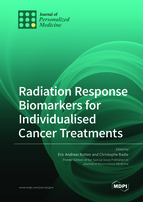Radiation Response Biomarkers for Individualised Cancer Treatments
A special issue of Journal of Personalized Medicine (ISSN 2075-4426). This special issue belongs to the section "Methodology, Drug and Device Discovery".
Deadline for manuscript submissions: closed (10 December 2020) | Viewed by 44129
Special Issue Editors
Interests: carcinogenesis; radiation biology; leukaemia; biomarkers
Special Issue Information
Dear Colleagues,
Half of all patients diagnosed with cancer will undergo radiotherapy as part of their treatment. It is an important and effective tool in the arsenal to treat numerous solid tumours. However, even with precise planning, radiotherapy treatment outcome depends on multiple factors and can, in the process, damage healthy tissue with a degree of severity that is, until now, very difficult to predict. Moreover, radiotherapy induces cancer cell death by damaging their DNA and can also trigger the release of pro- and anti-inflammatory mediators.
Improving the precision of radiotherapy has long been the quest of cancer scientists and clinicians. Recent improvements in its precision have helped to deliver most of the dose to the tumour, sparing the surrounding healthy tissues, hence limiting radiation toxicity and long-term effects, such as therapy-related cancer caused by, amongst others, a combination of radiation-induced somatic mutations, modifications of the microenvironment, and inflammation. Biomarkers are essential for predicting and/or monitoring radiation exposure-associated effects. The aim of this Special Issue is to present an insight into the ongoing state-of-the-art research in the oncology radiation response biomarker field and its applications in the ever-evolving field of personalised medicine.
Biomarkers for cancer fall into two primary categories: diagnostic and predictive. In the case of radiotherapy for cancers, there is a need for both: (1) diagnosis of radiation response and subsequent effect on the cancer and (2) prediction of possible secondary cancers arising in the long term because of radiotherapy, e.g., acute myeloid leukaemia and sarcomas. Radiation biomarkers are thus necessary, not only for understanding the actual effects of treatment on a tumour, but also for monitoring the most effective total dose to the tumour and identifying mechanisms that may allow a tumour to resist radiation therapy, as well as identifying the risks to the patient stemming from the therapy. Ever-evolving technologies allow the detection and validation of new and emerging radiation biomarkers, whether genetic, epigenetic, cell-based, cell-free, or present in extracellular vesicles.
We welcome original scientific manuscripts (both clinical and research-based), reviews reporting novel findings in the field of radiation response, and biomarkers indicative of patient-tailored treatment and monitoring in both in vitro and in vivo systems, with a focus on research in human systems, as well as technical papers on new developments in protocols to study and validate these biomarkers.
Dr. Christophe Badie
Dr. Eric Andreas Rutten
Guest Editors
Manuscript Submission Information
Manuscripts should be submitted online at www.mdpi.com by registering and logging in to this website. Once you are registered, click here to go to the submission form. Manuscripts can be submitted until the deadline. All submissions that pass pre-check are peer-reviewed. Accepted papers will be published continuously in the journal (as soon as accepted) and will be listed together on the special issue website. Research articles, review articles as well as short communications are invited. For planned papers, a title and short abstract (about 100 words) can be sent to the Editorial Office for announcement on this website.
Submitted manuscripts should not have been published previously, nor be under consideration for publication elsewhere (except conference proceedings papers). All manuscripts are thoroughly refereed through a single-blind peer-review process. A guide for authors and other relevant information for submission of manuscripts is available on the Instructions for Authors page. Journal of Personalized Medicine is an international peer-reviewed open access monthly journal published by MDPI.
Please visit the Instructions for Authors page before submitting a manuscript. The Article Processing Charge (APC) for publication in this open access journal is 2600 CHF (Swiss Francs). Submitted papers should be well formatted and use good English. Authors may use MDPI's English editing service prior to publication or during author revisions.
Keywords
- Tumour
- Cancer treatment
- Ionizing radiation
- Biomarkers
- Personalised medicine
- Radiotherapy
- Radiosensitivity
- Immune system
- Inflammation
- Adverse normal tissue effects








